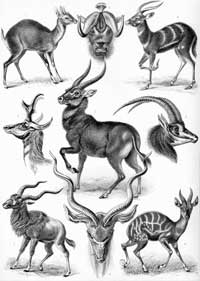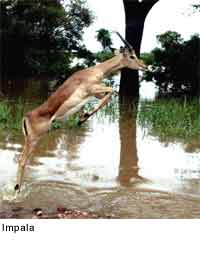|

 Apart from basic characteristics, antelopes differ from each other in appearance and physiology almost as much as they differ from other members of the cattle, goat, and sheep family. For example, the Common eland towers over most breeds of domestic cattle and can be 300 times heavier than the tiny Royal antelope. Apart from basic characteristics, antelopes differ from each other in appearance and physiology almost as much as they differ from other members of the cattle, goat, and sheep family. For example, the Common eland towers over most breeds of domestic cattle and can be 300 times heavier than the tiny Royal antelope.
Legs: All antelopes have long, slender legs and powerful muscles where the upper legs meet the body, providing leverage and increasing leg stride and speed. Though antelopes are good jumpers, they are not particularly good climbers. A few do display good balance, such as the klipspringer, which stands on the tips of its hooves. The gerenuk, another African species, is one of the few antelopes that habitually stands on its back legs.
 Fur: Antelopes bear a dense coat with short fur. Most antelopes have fawn or brown-colored fur so they can camouflage themselves while eating. There are some exceptions, including the rare zebra duiker which has dark vertical stripes, and the gemsbok which has gray and black fur and a vivid black-and-white face. A common feature of the gazelle is a white rump, which flashes a warning to others when it runs from danger. One species of gazelle, the springbok, also has a pouch of white brushlike hairs running along its back. When a springbok senses danger, its pouch opens up, and the hairs stand on end. Fur: Antelopes bear a dense coat with short fur. Most antelopes have fawn or brown-colored fur so they can camouflage themselves while eating. There are some exceptions, including the rare zebra duiker which has dark vertical stripes, and the gemsbok which has gray and black fur and a vivid black-and-white face. A common feature of the gazelle is a white rump, which flashes a warning to others when it runs from danger. One species of gazelle, the springbok, also has a pouch of white brushlike hairs running along its back. When a springbok senses danger, its pouch opens up, and the hairs stand on end.
Diet: Antelopes are ruminants. Like other ruminants, such as cattle and sheep, they have well-developed cheek teeth or molars, which grind cud into a pulp. They have no upper incisors; in order to tear grass stems and leaves, their lower incisors press against a hard upper gum pad when they bite.
Senses: Antelopes rely on their keen senses to avoid predators. Their eyes are on the sides of their heads, and their pupils are elongated horizontally, giving them a broad view of danger from both the back and front. Their senses of smell and hearing are also acute, giving them the ability to perceive danger while out in the open where predators often prowl after dark.
 Horns: Both sexes of most antelope species grow horns, though the males' horns are generally larger. The dik-dik and klipspringer, two species where the male mates with only one female, have horns that are little more than spikes. However, in species where males compete to mate with several females, horns may grow as long as 1.5 m (5 ft.). Despite their large size, antelope horns are hollow and lightweight. Antelope horns are almost always slightly curved, although in some species such as the blackbuck, they are shaped like a pair of corkscrews spiraling out in opposite directions. Horns: Both sexes of most antelope species grow horns, though the males' horns are generally larger. The dik-dik and klipspringer, two species where the male mates with only one female, have horns that are little more than spikes. However, in species where males compete to mate with several females, horns may grow as long as 1.5 m (5 ft.). Despite their large size, antelope horns are hollow and lightweight. Antelope horns are almost always slightly curved, although in some species such as the blackbuck, they are shaped like a pair of corkscrews spiraling out in opposite directions.
Males Are Larger: In many species, the males are larger than the females. In several species, such as the Asian blackbuck, males and females also differ in color.
Life Span: Antelope life spans are hard to determine, and most known figures relate only to those in captivity. Captive gnus have lived to be over 20 years old, and captive impalas have lived into their late teens. In the wild, antelopes rarely live to their teens, as they are often preyed upon.

Intelligence: Unlike carnivores and primates, herbivores such as the antelope are not noted for high intelligence. Since their food cannot run, antelopes do not have to be quick-thinking. However, they can be very clever in escaping from their enemies.
 Speed: Antelopes are fast runners, although they are not the fastest animals in the world. They are good at quick, precise turns, and they can run very fast for extended periods of time. This gives them an advantage over many predators such as the cheetah, which relies on sprinting and can be tired out by the antelope's greater stamina. Speed: Antelopes are fast runners, although they are not the fastest animals in the world. They are good at quick, precise turns, and they can run very fast for extended periods of time. This gives them an advantage over many predators such as the cheetah, which relies on sprinting and can be tired out by the antelope's greater stamina.
Escape: The antelope's choice to flee is based largely on the type of predator and its distance from the herd. Usually, gazelles will permit lions to come within 200 m (650 ft.) before fleeing. They likely recognize that a hunting lion prefers to hide while stalking its prey, meaning a visible lion is unlikely to attack. Cheetahs, who are superb sprinters, pose a more dangerous threat. Gazelles will flee from cheetahs when they are over 800 m (0.5 mi.) away.
 Communication: Antelopes communicate with each other using a varied array of sounds. For example, dik-diks whistle when alarmed, warning other animals of danger as well. This characteristic makes dik-diks less favorable prey for hunters. Generally, though, sight is a much more common form of communication than sound among antelopes. An antelope's mood is indicated by its posture and movement. When excited or alarmed, most medium-sized species of antelope bounce up and down on all four legs, keeping them stretched out straight. This behavior, known as pronking or stotting, acts as an alarming display. Some biologists theorize that stotting also sends a message to predators, showing that individual antelopes are fit and alert, and therefore not worth pursuing. Communication: Antelopes communicate with each other using a varied array of sounds. For example, dik-diks whistle when alarmed, warning other animals of danger as well. This characteristic makes dik-diks less favorable prey for hunters. Generally, though, sight is a much more common form of communication than sound among antelopes. An antelope's mood is indicated by its posture and movement. When excited or alarmed, most medium-sized species of antelope bounce up and down on all four legs, keeping them stretched out straight. This behavior, known as pronking or stotting, acts as an alarming display. Some biologists theorize that stotting also sends a message to predators, showing that individual antelopes are fit and alert, and therefore not worth pursuing.
Scent: Antelopes also use scent signals to communicate; these signals can linger for many days. Antelopes that live in herds have special glands in their hooves that leave a scented record of their movement. If an antelope were accidentally separated from its herd, it would be able to follow the scent tracks back.
 Migration: Antelope species common to forests tend to stay in the same place all their lives, but species that live out in the open often migrate to feed and breed. The gnus carry out the most famous of these migrations through the plains and open woodlands of eastern and southern Africa. Gnus are sedentary in some places, but in others, such as Serengeti National Park, gnus travel between two different home ranges. One of these ranges is used during the dry season, while another is used during the wet season. Migration can be very risky; the dangers include crossing crocodile-infested rivers, but migration also supplies the gnus with food at different times of the year. Migration: Antelope species common to forests tend to stay in the same place all their lives, but species that live out in the open often migrate to feed and breed. The gnus carry out the most famous of these migrations through the plains and open woodlands of eastern and southern Africa. Gnus are sedentary in some places, but in others, such as Serengeti National Park, gnus travel between two different home ranges. One of these ranges is used during the dry season, while another is used during the wet season. Migration can be very risky; the dangers include crossing crocodile-infested rivers, but migration also supplies the gnus with food at different times of the year.

There are about 90 species of antelope in about 30 genera, of which about 15 species are endangered. These include:
* addax
* bluebuck
* bongo
* bontebok
* common eland
* dik-dik
* duiker
* gazelle
* gemsbok
* hartebeest
* impala
* klipspringer
* kudu
* nyala
* oribi
* oryx
* Grey Rhebok
* roan antelope
* royal antelope
* sable antelope
* springbok
* suni
* tibetan antelope
* topi
* waterbuck
* wildebeest
Imports: Blackbuck antelope have been imported into the United States, primarily for the purpose of "exotic game hunts," common and popular in Texas. There are no true antelope native to the Americas. The pronghorn antelope of the Great Plains belongs to the family Antilocapridae. The Mongolian gazelle (Procapra gutturosa), sometimes classified as an antelope, can run with a speed of 80 km/h (50 mph). Suni are small antelope that live in south-eastern Africa. They stand between 12-17 inches high at the shoulder and are very similar to the dik-dik in size, shape and color, but have many smaller differences.
Antelope are not a cladistic group in and of themselves, but rather are considered a miscellaneous group. The term is used loosely to describe all members of the family Bovidae who do not fall under the category of sheep, cattle or goats. Native antelope can be found in Asia, India, and Africa.
All text is available under the terms
of the GNU Free Documentation License |